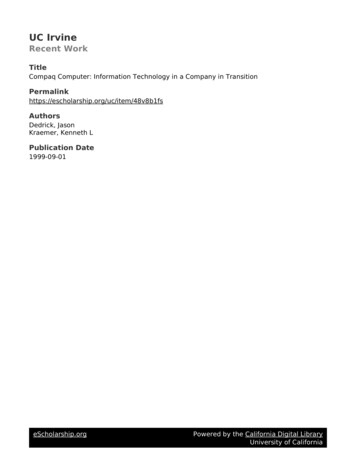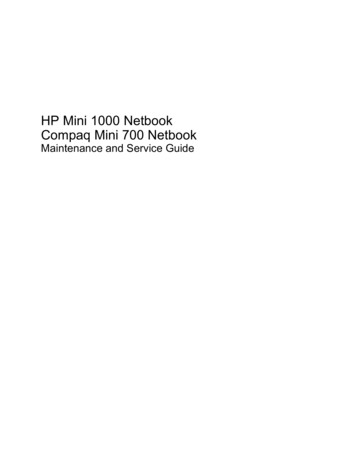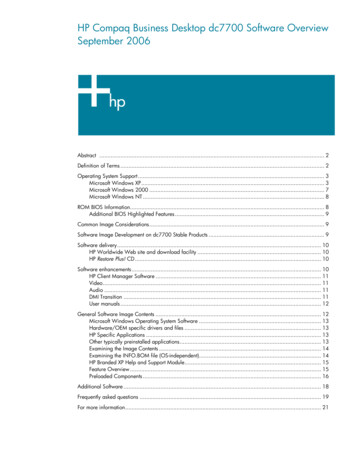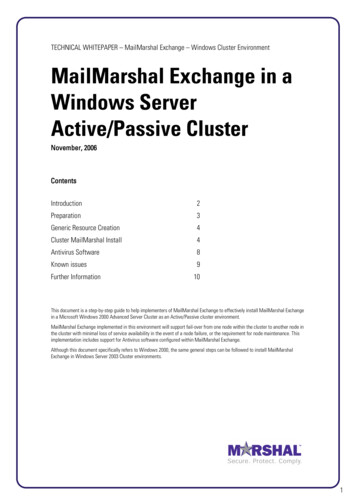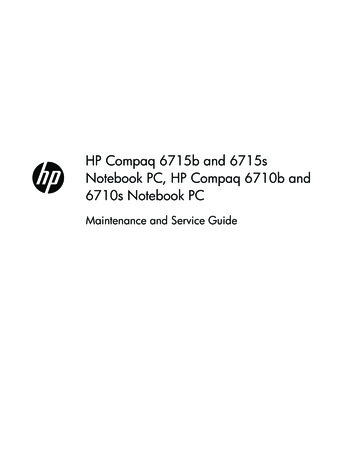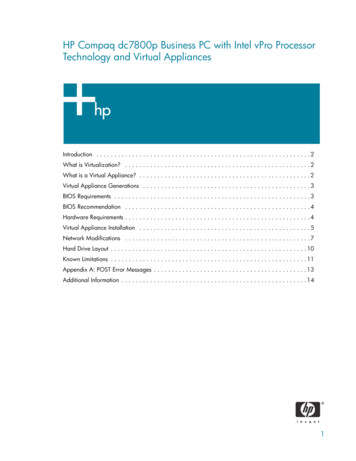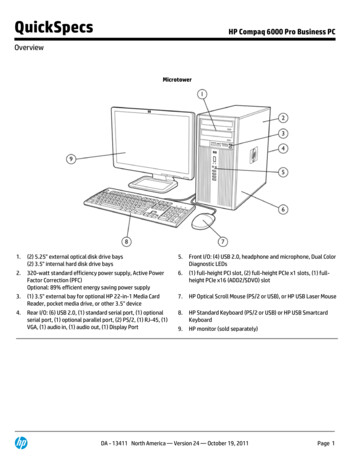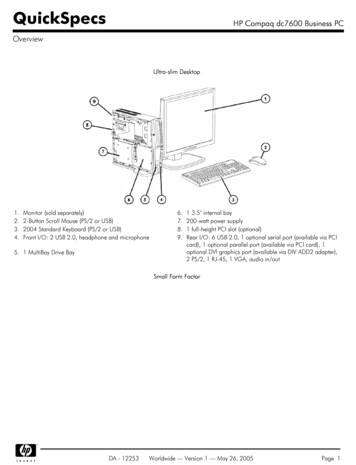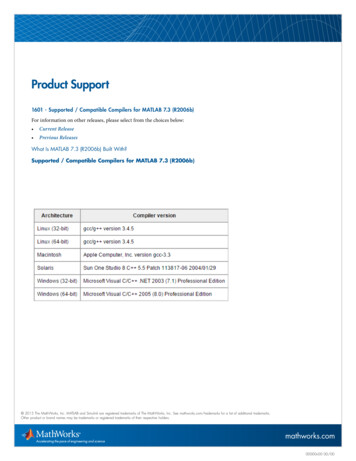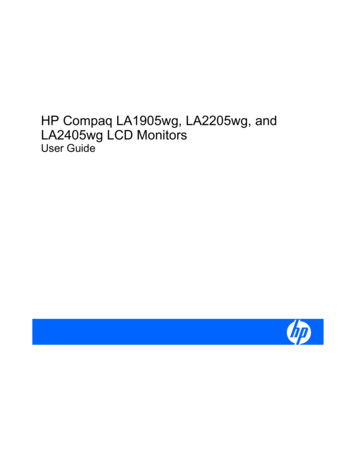
Transcription
HP Compaq LA1905wg, LA2205wg, andLA2405wg LCD MonitorsUser Guide
2009 Hewlett-Packard DevelopmentCompany, L.P.Microsoft, Windows, and Windows Vista areeither trademarks or registered trademarksof Microsoft Corporation in the United Statesand/or other countries.The only warranties for HP products andservices are set forth in the express warrantystatements accompanying such productsand services . Nothing herein should beconstrued as constituting an additionalwarranty. HP shall not be liable for technicalor editorial errors or omissions containedherein.This document contains proprietaryinformation that is protected by copyright. Nopart of this document may be photocopied,reproduced, or translated to anotherlanguage without the prior written consent ofHewlett-Packard Company.Second Edition (October 2009)Document Part Number: 537704-002
About This GuideThis guide provides information on setting up the monitor, installing drivers, using the on-screen displaymenu, troubleshooting and technical specifications.WARNING! Text set off in this manner indicates that failure to follow directions could result in bodilyharm or loss of life.CAUTION: Text set off in this manner indicates that failure to follow directions could result in damageto equipment or loss of information.NOTE:ENWWText set off in this manner provides important supplemental information.iii
ivAbout This GuideENWW
Table of contents1 Product FeaturesHP LCD Monitors . 12 Safety and Maintenance GuidelinesImportant Safety Information . 3Maintenance Guidelines . 4Cleaning the Monitor . 4Shipping the Monitor . 43 Setting Up the MonitorUnfolding the Monitor Pedestal Base . 5Rear Components . 6Connecting the Cables . 7Adjusting the Monitor . 8Turning on the Monitor . 10Connecting USB Devices . 11Removing the Monitor Pedestal Base . 12Mounting the Monitor . 13Locating the Rating Labels . 14Installing a Cable Lock . 144 Operating the MonitorSoftware and Utilities . 15The Information File . 15The Image Color Matching File . 15Installing the .INF and .ICM Files . 16Installing from the CD . 16Downloading from the Worldwide Web . 16Using the Auto-Adjustment Function . 17Front Panel Controls . 18Adjusting the Monitor Settings . 19Using the On-Screen Display Menu . 19OSD Menu Selections . 20ENWWv
Optimizing Digital Conversion . 23Using the HP Display Assistant Utility . 24Identifying Monitor Conditions . 24Sleep Timer Mode . 25HP Display LiteSaver . 26Installing the HP Display LiteSaver Software . 26sRGB Support . 27Changing the Color Temperature . 27Installing the sRGB ICM File for Microsoft Windows 2000 and Windows XP . 27Installing the sRGB ICM File for Microsoft Windows Vista . 28Installing the sRGB ICM File for Microsoft Windows 7 . 28Appendix A TroubleshootingSolving Common Problems . 29Online Technical Support . 31Preparing to Call Technical Support . 31Appendix B Technical SpecificationsLA1905wg Model . 32LA2205wg Model . 33LA2405wg Model . 34Recognizing Preset Display Resolutions . 36LA1905wg Model . 36LA2205wg Model . 36LA2405wg Model . 36Entering User Modes . 37Energy Saver Feature . 37Appendix C Agency Regulatory NoticesFederal Communications Commission Notice . 38Modifications . 38Cables . 38Declaration of Conformity for Products Marked with the FCC Logo (United States Only) . 38Canadian Notice . 39Avis Canadien . 39European Union Regulatory Notice . 39German Ergonomics Notice . 40Japanese Notice . 40Korean Notice . 40Power Cord Set Requirements . 40Japanese Power Cord Requirements . 40Product Environmental Notices . 41ENERGY STAR Qualification . 41viENWW
Materials Disposal . 41Disposal of Waste Equipment by Users in Private Household in the EuropeanUnion . 42HP Recycling Program . 42Chemical Substances . 42Restriction of Hazardous Substances (RoHS) . 42Turkey EEE Regulation . 43Appendix D LCD Monitor Quality and Pixel PolicyENWWvii
viiiENWW
1Product FeaturesHP LCD MonitorsThe LCD (liquid crystal display) monitors have an active matrix, thin-film transistor (TFT) panel. Themonitor models and features include:ENWW LA1905wg model, 48.1 cm (19-inch) diagonal viewable area display with 1440 900 resolution,plus full-screen support for lower resolutions; includes custom scaling for maximum image sizewhile preserving original aspect ratio LA2205wg model, 55.88 cm (22-inch) diagonal viewable area display with 1680 x 1050 resolution,plus full-screen support for lower resolutions; includes custom scaling for maximum image sizewhile preserving original aspect ratio LA2405wg model, 60.96 cm (24-inch) diagonal viewable area display with 1920 x 1200 resolution,plus full-screen support for lower resolutions; includes custom scaling for maximum image sizewhile preserving original aspect ratio Wide viewing angle to allow viewing from a sitting or standing position, or moving side-to-side Tilt capability Pivot capability to rotate display to portrait mode Swivel and height adjustment capabilities Removable stand for flexible monitor panel mounting solutions Video signal input to support VGA analog with VGA signal cable provided Video signal input to support DVI digital with DVI-D signal cable provided Video signal input to support DisplayPort digital (DisplayPort cable not provided) USB 2.0 hub with one upstream port (connects to the computer) and two downstream ports(connects to USB devices) USB cable provided to connect the monitor's USB hub to the USB connector on the computer Supports an optional HP speaker bar Plug and play capability if supported by the system Privacy filter slots to insert filters (purchased separately) to block side screen viewing Security slot provision on rear of monitor for optional cable lock Cable management feature for placement of cables and cordsHP LCD Monitors1
2 On-Screen Display (OSD) adjustments in several languages for easy setup and screenoptimization HP Display Assistant for adjusting monitor settings Pivot Pro software for viewing information on the screen in portrait mode Theft deterrence software HDCP copy protection on DVI and DisplayPort inputs Software and documentation CD that includes monitor drivers and product documentation Energy saver feature to meet requirements for reduced power consumption Energy Star qualified Intelligent Management AssetControl Compliant with the following regulated specifications: European Union CE Directives Swedish TCO RequirementsChapter 1 Product FeaturesENWW
2Safety and Maintenance GuidelinesImportant Safety InformationA power cord is included with the monitor. If another cord is used, use only a power source andconnection appropriate for this monitor. For information on the correct power cord set to use with themonitor, refer to the Power Cord Set Requirements on page 40 in Appendix C.WARNING! To reduce the risk of electric shock or damage to the equipment: Do not disable the power cord grounding feature. The grounding plug is an important safety feature. Plug the power cord in a grounded (earthed) outlet that is easily accessible at all times. Disconnect power from the product by unplugging the power cord from the electrical outlet.For your safety, do not place anything on power cords or cables. Arrange them so that no one mayaccidentally step on or trip over them. Do not pull on a cord or cable. When unplugging from the electricaloutlet, grasp the cord by the plug.To reduce the risk of serious injury, read the Safety and Comfort Guide. It describes proper workstation,setup, posture, and health and work habits for computer users, and provides important electrical andmechanical safety information. This guide is located on the Web at http://www.hp.com/ergo and/or onthe documentation CD, if one is included with the monitor.CAUTION: For the protection of the monitor, as well as the computer, connect all power cords for thecomputer and its peripheral devices (such as a monitor, printer, scanner) to some form of surgeprotection device such as a power strip or Uninterruptible Power Supply (UPS). Not all power stripsprovide surge protection; the power strips must be specifically labeled as having this ability. Use a powerstrip whose manufacturer offers a Damage Replacement Policy so you can replace the equipment, ifsurge protection fails.ENWWImportant Safety Information3
Maintenance GuidelinesTo enhance the performance and extend the life of the monitor: Do not open the monitor cabinet or attempt to service this product yourself. Adjust only thosecontrols that are covered in the operating instructions. If the monitor is not operating properly orhas been dropped or damaged, contact an authorized HP dealer, reseller, or service provider. Use only a power source and connection appropriate for this monitor, as indicated on the label/back plate of the monitor. Be sure the total ampere rating of the products connected to the outlet does not exceed the currentrating of the electrical outlet, and the total ampere rating of the products connected to the cord doesnot exceed the rating of the cord. Look on the power label to determine the ampere rating (AMPSor A) for each device. Install the monitor near an outlet that you can easily reach. Disconnect the monitor by grasping theplug firmly and pulling it from the outlet. Never disconnect the monitor by pulling the cord. Turn the monitor off when not in use. You can substantially increase the life expectancy of themonitor by using a screen saver program and turning off the monitor when not in use.NOTE: Monitors with a “burned-in image” are not covered under the HP warranty. Slots and openings in the cabinet are provided for ventilation. These openings must not be blockedor covered. Never push objects of any kind into cabinet slots or other openings. Do not drop the monitor or place it on an unstable surface. Do not allow anything to rest on the power cord. Do not walk on the cord. Keep the monitor in a well-ventilated area, away from excessive light, heat or moisture. When removing the monitor stand, you must lay the monitor face down on a soft area to preventit from getting scratched, defaced, or broken.Cleaning the Monitor1.Turn off the monitor and unplug the power cord from the back of the unit.2.Dust the monitor by wiping the screen and the cabinet with a soft, clean antistatic cloth.3.For more difficult cleaning situations, use a 50/50 mix of water and Isopropyl alcohol.CAUTION: Spray the cleaner onto a cloth and use the damp cloth to gently wipe the screen surface.Never spray the cleaner directly on the screen surface. It may run behind the bezel and damage theelectronics.CAUTION: Do not use cleaners that contain any petroleum based materials such as benzene, thinner,or any volatile substance to clean the monitor screen or cabinet. These chemicals may damage themonitor.Shipping the MonitorKeep the original packing box in a storage area. You may need it later if you move or ship the monitor.4Chapter 2 Safety and Maintenance GuidelinesENWW
3Setting Up the MonitorTo set up the monitor, ensure that the power is turned off to the monitor, computer system, and otherattached devices, then follow the instructions below.Unfolding the Monitor Pedestal Base1.Lift the monitor from its box and place it face down on a flat surface.2.Hold down the monitor base with one hand (1) then grasp the handle with the other hand and unfoldthe display head 90 degrees (2).CAUTION: Do not touch the surface of the LCD panel. Pressure on the panel may cause nonuniformity of color or disorientation of the liquid crystals. If this occurs the screen will not recover to itsnormal condition.Figure 3-1 Unfolding the Monitor Pedestal BaseNOTE: When the monitor is unfolded for the first time, the display head is locked from adjusting to afull-height position. To adjust the display head to full height, press down on the display head to unlockit then pull up on the display head to raise it to the full-height position.ENWWUnfolding the Monitor Pedestal Base5
Rear ComponentsFigure 3-2 Rear Components6ComponentFunction1AC Power ConnectorConnects the AC power cord to the monitor.2DisplayPortConnects the DisplayPort cable (not included) to the monitor.3DVIConnects the DVI-D cable to the monitor.4VGAConnects the VGA cable to the monitor.5USB UpstreamConnectorConnects the USB hub cable to the monitor's USB hubconnector and to a host USB port/hub.6USB DownstreamConnectors (2)Connects optional USB devices to the monitor.Chapter 3 Setting Up the MonitorENWW
Connecting the Cables1.Place the monitor in a convenient, well-ventilated location near the computer.NOTE:2.Before connecting the cables, route them through the opening on the monitor's pedestal.Connect a VGA signal cable, DVI-D signal cable, or DisplayPort signal cable.NOTE: The monitor is capable of supporting either analog or digital input. The video mode isdetermined by the video cable used. The monitor will automatically determine which inputs havevalid video signals. The inputs can be selected by pressing the /Source button on the front panelor through the On-Screen Display (OSD) feature by pressing the Menu button. For analog operation, use the VGA signal cable provided. Connect the VGA signal cable tothe VGA connector on the rear of the monitor and the other end to the VGA connector on thecomputer. For DVI digital operation, use the DVI-D signal cable provided. Connect the DVI-D signal cableto the DVI connector on the rear of the monitor and the other end to the DVI connector on thecomputer. For DisplayPort digital operation, use a DisplayPort signal cable (not provided). Connect theDisplayPort signal cable to the DisplayPort connector on the rear of the monitor and the otherend to the DisplayPort connector on the computer.3.Connect one end of the provided USB cable to the USB hub connector on the rear panel of thecomputer, and the other end to the upstream USB connector on the monitor.4.Connect one end of the power cable to the AC power connector on the back of the monitor, andthe other end to an electrical wall outlet.Figure 3-3 Connecting the CablesENWWConnecting the Cables7
WARNING! To reduce the risk of electric shock or damage to the equipment:Do not disable the power cord grounding plug. The grounding plug is an important safety feature.Plug the power cord into a grounded (earthed) electrical outlet that is easily accessible at all times.Disconnect power from the equipment by unplugging the power cord from the electrical outlet.For your safety, do not place anything on power cords or cables. Arrange them so that no one mayaccidentally step on or trip over them. Do not pull on a cord or cable. When unplugging from the electricaloutlet, grasp the cord by the plug.NOTE:An optional speaker bar that mounts on to the monitor is available from HP.Adjusting the MonitorNOTE:1.Your monitor model may look different than the model in the following illustrations.Tilt the monitor's panel forward or backward to set it to a comfortable eye level.Figure 3-4 Tilting the Monitor8Chapter 3 Setting Up the MonitorENWW
2.Swivel the monitor to the left or right for the best viewing angle.Figure 3-5 Swiveling the Monitor3.Adjust the monitor's height so that it is parallel to your eye height for a comfortable viewing position.NOTE: When the monitor is unfolded for the first time, the display head is locked from adjustingto a full-height position. To adjust the display head to full height, press down on the display headto unlock it then pull up on the display head to raise it to the full-height position.Figure 3-6 Adjusting the Height4.ENWWPivot the monitor from landscape to portrait orientation viewing to adapt to your application.a.Adjust the monitor to the full height position and tilt the monitor back to the full tilt position (1).b.Pivot the monitor clockwise 90 from landscape to portrait orientation (2).Adjusting the Monitor9
CAUTION: If the monitor is not in full height and full tilt position when pivoting, the bottomright corner of the monitor panel will come in contact with the base and potentially causedamage to the monitor.Figure 3-7 Pivoting the MonitorNOTE: To view information on the screen in portrait mode, you will need to install the Pivot Prosoftware included on the software and documentation CD. The position of the OSD menu can alsobe rotated to portrait mode. To rotate the OSD menu, access the OSD menu by pressing theMenu button on the front panel, select OSD Control, then select Rotate OSD.Turning on the Monitor1.Press the power button on the computer to turn it on.2.Press the power button on the front of the monitor to turn it on.CAUTION: Burn-in image damage may occur on monitors that display the same static image onscreen for a prolonged period of time.* To avoid burn-in image damage on the monitor screen, youshould always activate a screen saver application or turn off the monitor when it is not in use for aprolonged period of time. Image retention is a condition that may occur on all LCD screens. Monitorswith a “burned-in image” are not covered under the HP warranty.* A prolonged period of time is 12 consecutive hours of non-use.NOTE: If pressing the power button has no effect, the Power Button Lockout feature may be enabled.To disable this feature, press and hold the monitor power button for 10 seconds.NOTE: You can disable the power LED in the OSD menu. Press the Menu button on the front of themonitor, then select Management Bezel Power LED Off.When the monitor is powered on, a Monitor Status message is displayed for five seconds. The messageshows which input (DisplayPort, DVI, or VGA) is the current active signal, the status of the auto-switchsource setting (On or Off; factory default is On), the default source signal (factory default is DisplayPort),the current preset display resolution, and the recommended preset display resolution.The monitor automatically scans the signal inputs for an active input and uses that input for the display.If two or more inputs are active, the monitor will display the default input source. If the default source is10Chapter 3 Setting Up the MonitorENWW
not one of the active inputs, then the monitor will display the highest ranking priority input in the followingorder: DisplayPort, DVI, then VGA. You can change the default source in the OSD by pressing the frontpanel menu button and selecting Source Control Default Source.Connecting USB DevicesUSB connectors are used to connect devices such as a digital camera, USB keyboard, or USB mouse.Two USB connectors are located on the side panel of the monitor.NOTE: You must connect the USB hub cable from the monitor to the computer to enable the USB 2.0ports on the monitor. Refer to Step 3 in Connecting the Cables on page 7.Figure 3-8 Connecting USB DevicesENWWConnecting USB Devices11
Removing the Monitor Pedestal BaseYou can remove the monitor panel from the pedestal base to install the panel on a wall, a swing arm,or other mounting fixture.CAUTION: Before beginning to disassemble the monitor, be sure the monitor is turned off and thepower and signal cables are both disconnected. Also disconnect all USB cables connected to themonitor.1.Disconnect and remove the signal, power, and USB cables from the monitor.2.Lay the monitor face down on a flat surface covered by a clean, dry cloth.3.Pivot the base 45 degrees clockwise and remove the screw from the back of the monitor, then pivotthe base 45 degrees counter-clockwise and remove the other screw from the back of the monitor.Figure 3-9 Removing the Pedestal Base Screws4.Rotate the base of the monitor up (1) then pull it back (2) to unhinge the tabs on the monitor standfrom the slots in the monitor.Figure 3-10 Removing the Pedestal Base12Chapter 3 Setting Up the MonitorENWW
Mounting the MonitorThe monitor panel can be attached to a wall, swing arm, or other mounting fixture.NOTE:1.This apparatus is intended to be supported by UL or CSA Listed wall mount bracket.Remove the monitor panel from the pedestal base. Refer to Removing the Monitor PedestalBase on page 12 in the previous section.CAUTION: This monitor supports the VESA industry standard 100 mm mounting holes. To attacha third-party mounting solution to the monitor, four 4 mm, 0.7 pitch, and 10 mm long screws arerequired. Longer screws must not be used because they may damage the monitor. It is importantto verify that the manufacturer’s mounting solution is compliant with the VESA standard and is ratedto support the weight of the monitor display panel. For best performance, it is important to use thepower and video cables provided with the monitor.2.To attach the monitor to a swing arm, insert four 10mm screws through the holes on the swing armplate and into the mounting holes on the monitor.Figure 3-11 Mounting the MonitorTo attach the monitor to other mounting fixtures, follow the instructions included with the mountingfixture to ensure that the monitor is safely attached.3.ENWWReconnect the cables to the monitor panel.Removing the Monitor Pedestal Base13
Locating the Rating LabelsThe rating labels on the monitor provide the spare part number, product number, and serial number.You may need these numbers when contacting HP about the monitor model. The rating labels arelocated on the rear panel of the monitor display head.Figure 3-12 Locating the Rating LabelsInstalling a Cable LockYou can secure the monitor to a fixed object with an optional cable lock available from HP.14Chapter 3 Setting Up the MonitorENWW
4Operating the MonitorSoftware and UtilitiesThe CD that comes with the monitor contains files you can install on the computer: an .INF (Information) file an .ICM (Image Color Matching) file auto-adjustment pattern utility additional software for the monitor modelNOTE: If the monitor does not include a CD, the .INF and .ICM files can be downloaded from the HPmonitors support Web site. See Downloading from the Worldwide Web on page 16 in this chapter.The Information FileThe .INF file defines monitor resources used by Microsoft Windows operating systems to ensure monitorcompatibility with the computer’s graphics adapter.This monitor is Microsoft Windows Plug and Play compatible and the monitor will work correctly withoutinstalling the .INF file. Monitor Plug and Play compatibility requires that the computer’s graphic card isVESA DDC2–compliant and that the monitor connects directly to the graphics card. Plug and Play doesnot work through separate BNC type connectors or through distribution buffers/boxes.The Image Color Matching FileThe .ICM files are data files that are used in conjunction with graphics programs to provide consistentcolor matching from monitor screen to printer, or from scanner to monitor screen. This file is activatedfrom within graphics programs that support this feature.NOTE: The ICM color profile is written in accordance with the International Color Consor
Turn off the monitor and unplug the power cord from the back of the unit. 2. Dust the monitor by wiping the screen and the cabinet with a soft, clean antistatic cloth. 3. For more difficult cleaning situations, use a 50/50 mix of water and Isopropyl alcohol. CAUTION: Spray the cleaner onto a cloth and use the damp cloth to gently wipe the .
